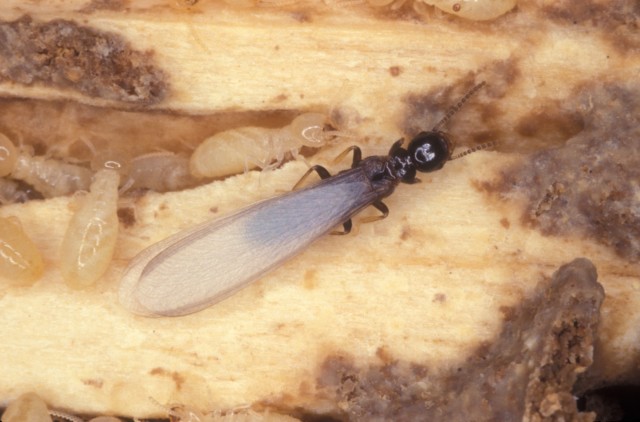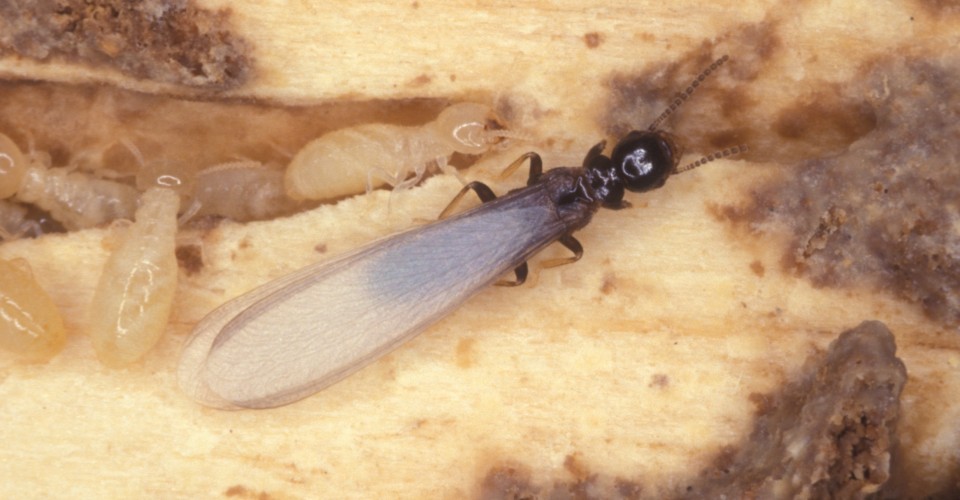Got termites? Afraid of termites? Not even sure what they are? Being aware of potential pest problems is one of the basic ways you can protect your home from damage. We decided to ask the experts at Orkin everything we ever wanted to know about these common household pests and what we can do to protect our home from invasion.
Give us the basics about termites. What are they, are there different species, what are the most common varieties?
There are more than 2,500 species of termites, and 50 of those species live in the U.S. Orkin focuses its treatment efforts on four types of termites that are common pests in and around our homes: subterranean termites, drywood termites, dampwood termites and Formosan termites.

Subterranean termite reproductives are dark-colored and have two pair of equal-length wings.
Native subterranean termites cause the majority of all termite damage in North America. This species of termite lives in colonies in the ground, building tunnels that look like mud tubes above ground to keep them moist while allowing them to search for food. Mud tubes are typically the color of the soil in which the termites are crawling. Subterranean termites need moisture to survive. Colonies can contain thousands of members, and there can be numerous colonies in one acre of land. There are three “castes” within a subterranean colony: workers are approximately 6 mm long, light-colored and wingless; soldiers have elongated heads with large mandibles, or jaws; reproductives are dark-colored and have two pair of equal-length wings.
Drywood termites are not as widespread as subterranean termites, but they can also cause serious damage to structures. This species of termite does not need contact with the soil to survive. Drywood termites commonly target the wood in your home’s structural timbers, framing, furniture and hardwood flooring. Drywood termite colonies can contain a few thousand members, and swarmers, or winged reproductives, can be up to 12 mm long.
There are several species of dampwood termites in the United States. Dampwood termites are much larger than the subterranean termites that are common across the country. The swarmers can be 25 mm long, including their wings. The soldiers can be as large as 20 mm. They have a large head with large mandibles on the front. There are no dampwood termite workers. The immature termites do the work in the colony. The immature termites may reach a length of 20 mm long. They get their name from the damp, sometimes decaying, wood that they use to establish their colonies. Dampwood termites do not typically nest in the soil. They will invade wood that is on the ground, especially if it is decaying. Dampwood termites are common along the Pacific coast. They are considered an economic pest. There are also dampwood termites in the Southwest desert and in southern Florida.
Formosan termites are an extremely aggressive species of subterranean termite found in tropical and sub-tropical climates. Formosan colonies are often 10 times larger than those of other subterranean species. They are able to cause damage at an accelerated rate.
Where are their favorite places to live?
Termite hot spots around the home include tree stumps and roots, which provide a source of food, water and moisture; mulch placed too close to the home; foundations that are not sloped away from the home; and concrete around utility pipes, as it leaves hidden spaces for termites after it has cooled and contracted.
What’s the biggest sign that my home might have termites? What should I look for?
It’s important to be on the lookout for a termite infestation around your home. Warning signs may include: a temporary swarm of winged insects, usually in the spring; discarded wings from swarmers; or other visible termite workers, which may look like small white ants.
Termite damage may also appear similar to that as damage caused by water. Outward signs can include buckling wood; swollen floors and ceilings; cracked or bubbling paint; and areas that appear to be suffering from slight water damage. The homeowner may also notice visible mazes within walls or furniture; wood that sounds hollow when tapped and mud tubes on exterior walls. Termite infestations also can exude a scent similar to mildew or mold.
What is the danger in waiting to treat my home for termites?
According to the National Pest Management Association (NPMA), termites cause more than $5 billion in damage every year in the United States. Termites are silent invaders. They can enter your home through cracks as tiny as 1/32 of an inch. Most homes, regardless of construction type, are vulnerable to termite attack.
Termites are a problem nationwide, as they can locate optimum conditions for activity in most environments. In the United States, most people think termites are just a problem in the Southeast, but unless you live in Alaska, your home or building can be a target for termites. It’s important to call a licensed professional like Orkin to protect your home because termites can cause extensive damage to homes and structures.
Is there any risk to my family or my home with your treatment plan?
Orkin uses EPA-registered materials developed to control termites. When applied in accordance with the product label, there is little threat to people and pets. However, Orkin always encourages you to share any concerns or questions with your pest specialist.
What other facts should I know about termites?
Termites are among the most ancient pests, surviving for more than 250 million years. Depending on the species and location, an average lot surrounding a home can support three to four colonies, which vary in size from thousands to millions of termites. Termites can travel up to 100 feet from their colony in search of food.
Termites are most active when temperatures are above 60 degrees. However, cold weather doesn’t kill termites. If they are associated with a home, the temperature is adequate for them to live year-round. Outside of the home, termites burrow deeper into the soil during the winter.
Tip of the Month
Door sweeps are an easy way to help keep pests and cold air from entering your home this winter. Install them now before temperatures dip too low.
Thank you Orkin! To find a termite control professional in your area start here.
Image credits: all images courtesy of Orkin




